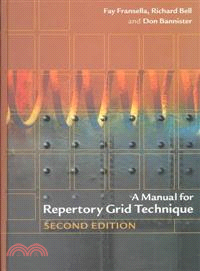A Manual For Repertory Grid Technique 2E
商品資訊
ISBN13:9780470854891
出版社:John Wiley & Sons Inc
作者:Fransella
出版日:2003/10/24
裝訂/頁數:精裝/272頁
商品簡介
Aimed at novices as well as those already knowledgeable about grid usage, this manual provides an overview of George Kelly’s personal construct theory, which underpins repertory grid methods. The reader will learn how to design a grid, with guidance on how to choose elements and ways of eliciting personal constructs that can influence the results obtained.
The second edition includes multiple examples of grids, as well as:
- New chapters on the main computer methods of analysis available
- Supporting website with grid analysis programs available to download
- Extended annotated bibliography of the many examples of grid usage
This book will appeal to psychology students, practitioners and academics. Other professionals who will find this an invaluable guide include managers, teachers and educationalists, speech and language therapists, nurses, probation officers and psychiatrists.
作者簡介
She trained and worked as an occupational therapist for 10 years before taking a degree in psychology and a postgraduate diploma in clinical psychology in 1962. It was during her first job as a lecturer at the Institute of Psychiatry, London, that she was introduced to George Kelly’s personal construct psychology and his repertory grid method. Both were revolutionary alternatives to the dominant behaviorism of the time. She found the view that we are all free agents responsible for what we make of the events which continually confront us particularly liberating. Since that time she has conducted research, together with teaching and writing, within the framework of Kelly’s ideas. Her main area of research has been stuttering, for which she used a form of repertory grid. She has also conducted research on weight disorders and various psychological problems.
Richard Bell is an Associate Professor of Psychology at the University of Melbourne. He is interested practical problems of measurement in clinical, organizational and educational settings. He has written extensively on the analysis of repertory grid data and has authored widely used software for the analysis of such data.
The influence of Don Bannister in arousing interest in George Kelly’s theory and methods of assessment has been profound. Even after his untimely death in 1986 his influence continues, through those he inspired, through his professional research and writings, and also through his four novels. In the year in which this second edition of the Manual for Repertory Grid Techniques is published the 15th International Congress in Personal Construct Psychology was held in Huddersfield, UK, focusing on that outstanding influence. He spent much of his professional life carrying out research for the UK Medical Research Council, which included a year working with George Kelly at Ohio State University in 1965. He saw the psychology of personal constructs as an approach to the person that was empowering, democratic and, above all, valuable in helping people understand themselves and others. He was insistent that psychologists should use what power and influence they have to make a difference in the lives of people. He would have taken great interest in the vast amount of new work that has been carried out with and into that tool which is detailed in this second edition of the book that he co-authored in 1977.
目次
Preface.
Acknowledgements.
1. The Basis of Repertory Grid Technique.
Grids: What Are They?
The Grid as Part of Personal Construct Theory.
Grids: a Measure of What?
Grids are about Constructs.
Some Personal Construct Theory Corollaries.
Different Kinds of Construct.
Constructs in Transition.
Conclusions.
2. Constructs And Elements.
What is an Element?
What is a Construct?
Elements in a Grid.
The Nature and Types of Constructs in a Grid.
Ways of Eliciting Personal Constructs from ’Elements’.
Eliciting Personal Constructs in Ways other than from ’Elements’.
Eliciting Constructs from Constructs.
To Elicit or to Supply Constructs?
Classification of Constructs.
Which are more Important in a Grid – Elements or Constructs?
Constructs and Elements: the Debate.
Comment.
3. Varieties Of Grid In Use Today.
The Grid Form of the Role Construct Repertory Test.
The Split-Half Method of Allocating Elements.
A Grid Using Rankings.
A Grid Using Ratings.
Implications and Resistance-to-Change Grids.
Resistance-to-Change Grid.
A Bipolar Implications Grid.
Dependency Grid.
A Textual Grid.
A Qualitative Grid.
Comment.
4. Analyzing Grid Data.
Repertory Grids.
Analyzing Constructs.
Analyzing Elements.
Joint Representations of Constructs and Elements.
Representations of Multiple Repertory Grid Data.
Dependency Grids.
Implications Grids.
Comments.
5. Some Summary Measures Of Structure.
Cognitive Complexity.
Extremity and Ordination.
Conflict.
Element Indices.
Measures of Superordinacy.
Measures of Intransitivity.
Implications Grids.
Dependency Grids.
Comment.
6. Reliability and Validity.
Reliability.
Conclusions.
Validity.
Conclusions.
7. Specific Ways Of Using Grids.
The Individual and the Grid.
A Decision-Making Grid.
Wholly or Partially Standardized Grid Formats.
Conclusions.
8. Some Uses To Which Grids Have Been Put.
Grids in General.
In the Clinical Setting.
Working with Children.
Teachers and Teaching.
The Construing of Professionals.
Those With Learning Difficulties.
Social Relationships.
Language.
Dependency.
The Use and Abuse of Drugs.
The Family.
Forensic Work.
Maps, Planning and Environment.
Market Research.
Politics.
Careers.
Sport.
Organizational and Business Applications.
More Unusual Uses of Grids.
Appendix: Computer Programs and Websites.
References.
Author Index.
Subject Index.
主題書展
更多書展今日66折
您曾經瀏覽過的商品
購物須知
外文書商品之書封,為出版社提供之樣本。實際出貨商品,以出版社所提供之現有版本為主。部份書籍,因出版社供應狀況特殊,匯率將依實際狀況做調整。
無庫存之商品,在您完成訂單程序之後,將以空運的方式為你下單調貨。為了縮短等待的時間,建議您將外文書與其他商品分開下單,以獲得最快的取貨速度,平均調貨時間為1~2個月。
為了保護您的權益,「三民網路書店」提供會員七日商品鑑賞期(收到商品為起始日)。
若要辦理退貨,請在商品鑑賞期內寄回,且商品必須是全新狀態與完整包裝(商品、附件、發票、隨貨贈品等)否則恕不接受退貨。
























